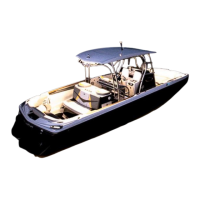togetherandinthesamedirection.Doingotherwisecandamagethesystem.
Thenextmiddleleveristheportenginethrottle,whichallowstheboattofeedfuelintotheengineandoperateinmotion.Pushingforwardon
itwillsignalthesystemthatfuelshouldbesenttotheportengine.Theenginescanberunatdierentlevelsofthrottle.
Thissystemallowsgreatermaneuverabilityindocking,aswellaswhentheboatisinoperation.However, it requires more practice and
skill in order to avoid potential damage to the boat. See Engine Synchronizing Switch in this section of the Owner’s Manual for more
details.
Duringregularwarm-upoftheengine,itispossibletotemporarilyincreasetheengineRPMswithoutmovingtheboat.Toaccomplishthis,set
theshiftertoneutralandadjustthethrottleasdesired.TheenginewillrunwithincreasedRPMsandcanbeincreasedordecreasedbymovingthe
lever.ReturnthethrottletoidlebeforeshiftingtoForwardorReverse.
Thisfunctionshouldbedonesparingly.Over-revvingtheengineforanyextendedperiodcancauseunduewearandtearontheengine.Avoid
advancingtowide-open-throttleandholdingtheRPMsatthatlevel.
Speedometer
(All Models)
The speedometer indicates
the forward speed of the boat in
miles per hour (unless the boat
is equipped with a speedometer
thatmeasureskilometersperhour,
which is available in the optional
Europeanpackage.)
To calibrate the speedometer, you need an ac-
curately measured course of 850feet and a certied
stopwatch,whichisaccuratetowithinone-hundredths
(.01) of a second. (This can bedone withGPS, when
equipped.)TocalibratetoA.W.S.A.ocialtournament
rules:
• Approach the course at 36 miles per hour (MPH)
as indicated on thespeedometer. Holdthe speed
steadyandhaveanobservercheckthecoursetime
withastopwatch.
• Ifthecoursetimeisbetween15.88and16.28sec-
onds,noadjustmentsarenecessary.
• Ifthecoursetimeisnotwithinthattolerancerange,
pressupordownonthecalibrationrockerswitchto
adjustthespeedometer’sspeedinterpretation.
Tachometer
(All Models)
Onboatsnotequippedwithamulti-functiongauge,
a separate tachometer gauge is found.The tachom-
eter indicates the
engine speed in
crankshaft revolu-
tions per minute
(RPM).
Temperature
Gauge
(All Models)
The temperature gauge indicates the
water temperature inside the engine’s
cooling system as measured in degrees
Fahrenheit. The normal operating tem-
perature will range from 140 degrees
Fahrenheit to 190 degrees Fahrenheit.
Engineswithelectronicfuelinjectionalsohaveacontrolcircuitinsidetheenginecon-
trolmodulethatwillcausetheenginetorunatreducedspeedsifthemodulesenses
thattheengineisrunningtoohot.Ifyounoticethatyourspeedhasreducedduring
normaloperation,butyouhavenotmanuallyslowedthethrottle,monitoryourtem-
peraturegauge.If the gauge indicates excessive temperatures during operation, slow
down immediately and turn o the engine.This indicates an engine problem that
needstobecheckedbythedealer!
Continuing to operate the boat while the temperature is above normal operat-
ing parameters may cause serious damage to your engine. Damage to your
engine resulting from operating the engine in an overheated condition can be
costly to repair. Such damage is not covered by your warranty!
Voltmeter
(All Models)
The voltmeter registers the electrical activity
necessarytooperateyourboat.Ifthebattery(or
batteries,inboatmodelsrequiringtwo[2])islow
ornon-functional,orifvariouselectricalitemson
theboat,suchasstereoequipment,aredraining
the battery(ies) and impacting the boat’s abil-
itytofunctionproperly,thevoltmeterwilllikely
be the rst gauge to indicate that you have an
electricalproblem.Thevoltmetercannottellyou
which battery is draining on boats with two (2)
batteries,butratherfunctionsasageneralalarm
to alert boaters regarding potential issues. On
boatsequippedwithtwo(2)batteries,thealarm
indicatesseveredrainontheenginestartingbattery.Todeterminewhichbatteryisthe
enginestartingbattery,readthemarkingsonthebatterycables.
MasterCraft 2012 Owners Manual • Guide to Individual Models • Page 2-36

